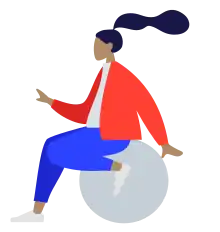
Corporate Memphis (alternative names: Alegria art, big tech art, flat art, or corporate artstyle[1]) is an art style named after the Memphis Group that features flat areas of color and geometric elements. Widely associated with Big Tech illustrations in the late 2010s[2] and early 2020s,[3] it has been criticized for its use in sanitising corporate communication,[2] as well as being seen as visually offensive, insincere, pandering and over-saturated,[1] though some illustrators have defended the style, pointing at what they claim to be its art-historical legitimacy.[4]
Origins
Flat art developed out of the rise of vector graphic programs, and a nostalgia for mid-century modern illustration.[4] It began to trend in editorial illustration and especially the tech industry, which relied on simple, scalable illustrations to fill white space and add character to apps and web pages.[2] The style was widely popularized when Facebook introduced Alegria, an illustration system commissioned from design agency Buck Studios and illustrator Xoana Herrera[2] in 2017.[5][6]
The name "Corporate Memphis" originated from the title of an Are.na board that collected early examples,[2] and is a reference to the Memphis Group, a 1980s design group known for bright colors, childish patterns, and geometric shapes.[6]
Visual characteristics
.jpg.webp)
Common motifs are flat human characters in action, with disproportionate features such as long and bendy limbs,[3] small torsos,[7] minimal or no facial features, and bright colors without any blending. Facebook's Alegria uses non-representational skin colors such as blues and purples in order to feel universal,[5] though some artists working in the style opt for more realistic skin colors and features to show diversity.[2] However, such style has overall been criticised for tokenism and feeling inauthentic.[1]
Corporate Memphis is materially quick, cheap and easy to produce, and thus appealing to companies; programs such as Adobe Illustrator can produce such designs rapidly.[1]
Reception
Once Facebook adopted the style, the sudden ubiquity of vector graphics led to a critical backlash.[4] The style has been criticized both professionally and popularly (including in myriad internet memes) for being overly minimalistic,[1] generic,[8] lazy,[3] overused, and attempting to sanitise public perception of big tech companies by presenting human interaction in utopian optimism.[2] Criticism of the art style is often rooted in larger anxieties about the creative industry under capitalism and neoliberalism.[7] Some have argued that, despite the criticism, Corporate Memphis has unexpected depth and variety, and deserves to be understood on its own merits beyond an association with tech dystopias.[4]
See also
- Material design, a Google-derived design language linked to Corporate Memphis
- Frutiger Aero, a prominent design style preceding Corporate Memphis that embraced contrasting skeuomorphism
- Flat design
- Postmodern art
- Metamodernism
- Pop art
- Capitalist Realism
References
- 1 2 3 4 5 McGinn, Julian. "It's Not Just You: Why People Hate "Corporate Art Style"". The Grand Geek Gathering. Archived from the original on 8 January 2024. Retrieved 8 January 2024.
- 1 2 3 4 5 6 7 Hawley, Rachel (2019-08-21). "Don't Worry, These Gangly-armed Cartoons Are Here to Protect You From Big Tech". Eye on Design. Archived from the original on 2021-08-22. Retrieved 2021-02-10.
- 1 2 3 Gabert-Doyon, Josh (2021-01-24). "Why does every advert look the same? Blame Corporate Memphis". Wired UK. ISSN 1357-0978. Archived from the original on 2021-08-22. Retrieved 2021-02-10.
- 1 2 3 4 Frey, Angelica (10 January 2022). "Facebook made a certain type of illustration ubiquitous—but it's time to stop knocking it". Fast Company. Archived from the original on 19 December 2022. Retrieved 18 December 2022.
- 1 2 "Facebook Alegria". Archived from the original on 19 November 2021. Retrieved 19 November 2021.
- 1 2 "Blue people and long limbs: How one illustration style took over the corporate world | Webflow Blog". Webflow. Archived from the original on 2022-11-16. Retrieved 2022-11-16.
- 1 2 Posture, Julien (2022-01-13). "What the Think Pieces About "Corporate Memphis" Tell Us About the State of Illustration". AIGA Eye on Design. Archived from the original on 2022-05-28. Retrieved 2022-05-10.
- ↑ Quito, Anne (October 26, 2019). "Why editorial illustrations look so similar these days". Quartz. Archived from the original on 2021-02-08. Retrieved 2021-02-10.